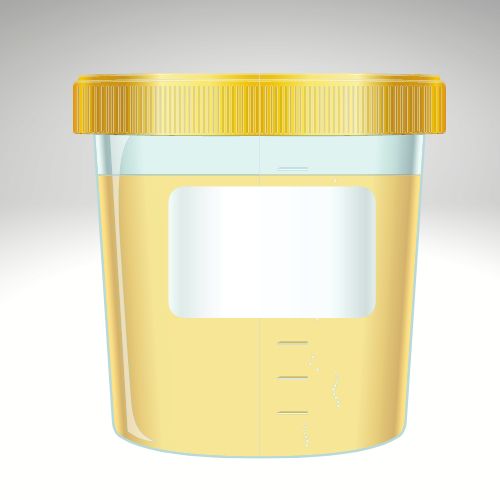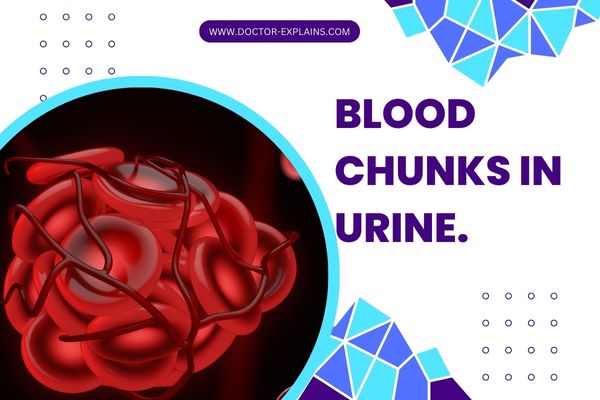5 Main causes of abdominal pain and blood in the urine
Our content is not intended nor recommended as a substitute for medical advice by your doctor. Use for informational purposes only.
Possible causes of abdominal pain and hematuria (blood in urine) are kidney or bladder stones, complicated and uncomplicated urinary tract infections, Trauma, cancers, or glomerulonephritis.
The table below summarizes the main causes of hematuria and abdominal pain and some clues to the diagnosis of each cause:
| CAUSES | CLUES TO DIAGNOSIS |
|---|---|
| 1. Stones in the urinary tract | Severe flank or loin pain that comes and goes in attacks. Bladder stones may cause lower abdominal pain. |
| 2. Urinary tract infections (UTI). | Common in females, it presents with acute onset burning urination, bladder (lower abdominal pain), or kidney (flank pain). Patients with UTI usually suffer from frequent painful urination. |
| 3. Cancer | vague pain in the bladder (lower abdominal) or the kidney area (loin pain) in patients with risk factors (older age, male gender, smoking, etc.). |
| 4. Trauma | Abdominal pain and hematuria often follow a procedure such as a cystoscopy or urinary catheter insertion or a history of recent trauma to the bladder, ureters, or kidney. |
| 5. Glomerulonephritis | one or more of the following symptoms may be present: Flank pain, brown urine, frothy urine, headache (high blood pressure), scanty urine, swollen limbs, attacks of fever or sore throat before the onset of pain, and hematuria. |
1. Stones in the urinary tract.
Urinary tract stones are one of the commonest causes of heavy blood in the stool (leading to worm-like or stringy blood clots in urine).
Kidney stones may cause injury when they move inside the urinary tract leading to hematuria with clots.
Common locations of the urinary tract stones:
- Kidney stones (may be asymptomatic in some cases).
- Urinary bladder stones.
- Ureteric stones.
- Urethra (rare).
Symptoms of stones in the urinary system:
- Kidney stones cause loin pain (in the flanks and upper back on both sides).
- Bladder stones often cause central pelvic pain (urinary bladder pain).
- Ureteric stones cause severe flank pain that radiates to the groin and the inner thigh.
- Some cases are completely asymptomatic and may present with isolated blood or worm-like clots in the urine.
- The pain is often sudden onset, severe, and colicky and may last minutes to hours.
- Turbid urine.
- The pain may be associated with nausea and/or vomiting.
- Heavy bleeding with blood clots in urine may also occur if the stone cause injury to any part of the urinary tract.
- Obstruction of the urine outflow can also occur in severe cases.
Urinary stones are often diagnosed by an imaging study such as an X-ray, ultrasound, or CT scan of the urinary tract.
You can learn more about urinary stones.
2. Urinary tract infection
Urinary tract infections (UTIs) are very common in females. Almost 50-60% of women will get UTI at some point in their lifetime (reference.
UTI commonly affects the urinary bladder (cystitis). When cysitis is severe, the lining of the urinary bladder may bleed due to severe inflammation leading to drops of blood at the end of urination in women.
Causes:
- Bacteria are the most common cause of UTIs (such as E. Coli).
- Bacteria reach the urinary bladder from outside through the urethra. It reaches the urethra by contamination from the stool.
- The most common risk factors include frequent sexual intercourse, spermicide-coated diaphragms, condoms, and diabetes mellitus.
- Recurrent simple cystitis (frequent UTIs) is very common in young and healthy women.
Symptoms & diagnosis:
- Dysuria: burning or pain in the urethra when you pee.
- Urgency: sudden severe urgency to pee.
- Frequency: Frequent urge to pee but only a small amount of urine comes out.
- Suprapubic (lower abdominal) pain.
- Turbid (cloudy) urine may also be present.
- Bloody urine or blood drops at the end of urine.
- The symptoms may be very mild, with a strange feeling in the bladder and urethra.
- Also, UTI may become complicated (reaching the kidneys), causing high fever, flank pain, chills, etc.
- The diagnosis is often established by urine analysis and culture.
What to do:
UTI is a very common cause of abnormal urinary symptoms in females. Consult your doctor to confirm the diagnosis if you have symptoms consistent with UTI.
UTIs are treated mainly by antibiotics (such as Nitrofurantoin and Trimethoprim-sulfamethoxazole).
The blood in urine often resolves with antibiotic treatment. However, if it doesn’t go away after UTI treatment, you should tell your doctor, as it may be due to other causes.
An over-the-counter urinary analgesic such as Oral phenazopyridine may help relieve the dysuria and uncomfortable urethral sensations.
. Trauma to the urinary tract.
Recent trauma, procedures, or catheter insertion are common causes of blood clots in urine.
Recalling any recent trauma or instrumentation of the urinary tract in the past few days before the appearance of worm-like clots in urine helps determine the cause.
Report any of the below incidents to your doctor or health care provider:
- Recent insertion of a urinary catheter.
- Trauma to the urethra during sexual activities or intercourse.
- Recent cystoscopy (a tool to visualize the bladder introduced through the urethra.
- Recent insertion of a ureteric stent (double-J stents).
- Recent operations (bladder, kidney, urethral, or prostatic).
- Taking a biopsy from the urinary bladder, kidney, or prostate.
- Blunt trauma to the perineum.
In most cases, the onset of blood clots in urine is shortly (minutes to hours) after the initial trauma). Seek immediate medical assistance in you experience blood clots after an identifiable trauma to the urinary tract.
. Bladder cancer & others.
Malignancy is often more common in the elderly. And both urinary bladder and kidney cancer cause blood in the urine.
You should consider bladder cancer as a cause of blood urine, especially if you have risk factors such as:
- Cigarette smoking.
- Females are generally less commonly affected by bladder cancer than men.
- Being older (more than 50).
- Opium use.
- Occupation exposure to carcinogens as with metal workers, painters, rubber industry workers, leather workers, textile and electrical workers, miners, cement workers, transport operators, excavating-machine operators, and jobs that involve the manufacture of carpets, paints, plastics, and industrial chemicals.
- Genetics also plays a role.
- Schistosomiasis infection (common in north Africa and Japan).
For kidney cancer, the risk factors are nearly the same, plus obesity, older age, hypertension, and a family history of kidney cancer.
Symptoms of urinary bladder cancer:
- Early bladder cancer may present with irritative symptoms such as painful urination (dysuria), the urgency to urinate, or frequent urination.
- Typically, bladder cancer causes painless bleeding in the urine (intermittent attacks of bloody urine or blood on tissue after urination).
- Blood is often present throughout the urination, but minor bleeding also occurs.
- Bladder pain or pressure in the lower abdomen (typically, no pain is present in patients with bladder cancer).
- Dysuria or pain after the end of urination.
- Signs of metastasis may also exist, such as bone pain, abdominal pain, liver pain, headache, or blurring of vision.
- Weight loss, anorexia, and other systemic symptoms may also present.
The symptoms of kidney cancer are the same, except the pain is often in the flanks. 25% of the cases of kidney cancers are completely asymptomatic.
Due to the higher risk of cancer in older ages, Any woman with blood in her urine should undergo investigations to exclude kidney and urinary bladder cancers.
. Glomerulonephritis.
Glomerulonephritis is inflammation and damage to the tiny urine filters inside your kidneys (the glomeruli).
Glomeruli nephritis is a relatively common disease and may cause significant kidney damage if undiagnosed or untreated.
Causes of glomerulonephritis:
- Infections (bacterial, viral, etc.).
- Medications (such as some antibiotics and nonsteroidal anti-inflammatory drugs).
- Some chemicals are harmful to the kidney.
- Autoimmune diseases such as systemic lupus erythematosus.
- Severe Hypertension.
- Long-lasting or uncontrolled diabetes mellitus.
- Many cases occur due to unknown causes.
Symptoms and signs:
The CT scans of acute cases of glomerulonephritis often reveal normal findings. Also there are two main types of glomerulonephritis:
- Nephritic Syndrome: mainly characterized by blood in the urine (light brown or pink urine) and hypertension.
- Nephrotic Syndrome: characterized by foamy urine (due to proteinuria), swelling of eyes (especially in the morning), and lower limbs.
The symptoms may include one or more of the following:
- Bloody urine (often pink, light brown, or tea-colored).
- Foamy urine (foams form on the toilet water’s surface after peeing).
- Headache.
- Sometimes, Fever, sore throat, and other signs of infection.
- The amount of urine may remain normal or decrease. Some patients may completely stop urination.
- Swelling of the face and eyelids (more noticeable in the morning).
- Swelling of the lower limbs.
- Some patients may present with acute kidney failure symptoms (severe shortness of breath, hiccups, headaches, dizziness, confusion, or loss of consciousness).
. Others.
| KIDNEY CAUSES |
|---|
| 1. benign or malignant kidney tumors. |
| 2. Glomerulonephritis (IgA nephropathy, Thin basement membrane disease, or Alport syndrome). |
| 3. Adult Polycystic Kidney Disease (APKD) |
| 4. Medullary sponge kidney. |
| 5. Pyelonephritis (kidney infection). |
| 6. Kidney distension with urine (hydronephrosis). |
| 7. Increased excretion of calcium or uric acid in urine. |
| 8. Severe (malignant) hypertension. |
| 9. Obstruction of the renal artery or renal vein. |
| 10. Arteriovenous malformation (abnormal blood vessels of the kidney). |
| 11. Papillary necrosis (with sickle cell disease). |
| URETERIC CAUSES |
| 1. Malignant ureteric tumor. |
| 2. Stone ureter. |
| 3. Stricture (narrowing) in the ureter. |
| 4. Polyp. |
| 5. Post-surgery (fistula between the iliac vessels and the ureter or ureteroiliac fistula). |
| URINARY BLADDER CAUSES |
| 1. UB cancer (most serious). |
| 2. Cystitis (UTI). |
| 3. UB stone. |
| 4. UB radiation. |
| PROSTATE & URETHRA |
| 1. BPH (benign prostatic hypertrophy). |
| 2. Prostatic cancer. |
| 3. Prostatic procedures such as taking a biopsy or operations. |
| 4. Trauma during urinary catheter insertion. |
| 5. Urethritis (inflammation of the urethritis). |
| 6. Urethral diverticulum. |
| ANYWHERE (KIDNEY, URETER, BLADDER, OR URETHRA) |
| 1. UTI (infection with bacteria, viruses, or fungi). |
| 2. Tuberculosis. |
| 3. Schistosomiasis |
| 4. Trauma. |
| 5. Exercise-induced hematuria. |
| 6. Recent interventions such as lithotripsy. |
| 7. Bleeding disorders or anticoagulant medications. |
| 8. Endometriosis of the urinary tract. |
| 1. Menstruation. |
| 2. Drugs (Pyridium, phenytoin, rifampin, nitrofurantoin). |
| 3. Red pigments in urine as myoglobinuria4. Beeturia. |
- Evidence-based
- Written by a doctor.
MD, Internal Medicine and Nephrology specialist.

Dr. Esraa A. MagidAuthor
MORE INSIGHTS





